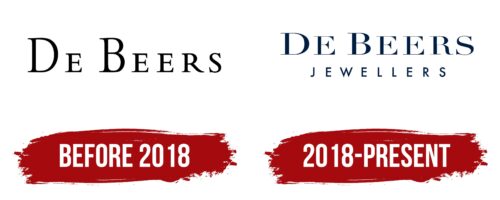The De Beers logo conveys the brand’s value paradigm, reflecting the beauty, grandeur, and charm that have always been associated with its name. It carries elements of luxury, as if inscribed with invisible ink, emphasizing the uniqueness and character of its identity. The creators of the iconic brand put effort into ensuring the visual image appears refined and respectable, evoking associations with the mysterious allure and distinctiveness of rare diamonds. Aristocracy and elegance are evident in every element, creating a sophisticated sense of luxury.
The accents on the emblem are designed to convey to the audience the company’s global significance as an international brand known worldwide. The visual symbol reminds us that the British brand, founded in 1888, is the largest corporation involved in mining, processing, and selling natural gems—diamonds.
De Beers: Brand overview
The story began in 1888 when British statesman and businessman Cecil Rhodes founded the company, naming it after the de Beers brothers. The brothers owned several South African diamond mines that were merged to create the firm.
In its early years, the focus was on consolidating South Africa’s diamond industry. Rhodes and his partners acquired smaller companies and diamond-rich land. By 1890, the company controlled about 90% of the global diamond production. This monopoly allowed it to regulate the supply of diamonds and maintain high prices.
After Cecil Rhodes passed away in 1902, the Oppenheimer family took control. Ernest Oppenheimer, founder of the Anglo-American Corporation, became chairman in 1929, solidifying the company’s position in the global market.
During the Great Depression in the 1930s, the company faced a sharp decline in diamond demand, leading to production cuts. However, during this period, the company also began developing a marketing strategy that would forever change the perception of diamonds.
The first marketing campaign was launched in the United States in 1938, promoting diamonds as symbols of love and luxury. The famous slogan “A Diamond is Forever,” introduced in 1947, became one of the most iconic advertising campaigns, influencing how people viewed diamonds for generations.
After World War II, the company continued to expand its influence, forming partnerships with newly established diamond-producing nations, including the Soviet Union, to maintain control over the global supply. The “single channel” model allowed the firm to regulate prices and ensure market stability.
In the 1960s and 1970s, challenges arose with discovering large diamond deposits in Australia, Siberia, and other regions. Despite these threats, the company negotiated with new producers, maintaining significant control over the market.
In the 1980s, the company was increasingly criticized for its monopolistic practices. It also had to address the issue of “conflict diamonds.” In response, the global community adopted the Kimberley Process in 2003 to prevent conflict diamonds from entering the market.
In the 2000s, the company shifted its business model, moving away from total market control and focusing more on building its brand and expanding its retail presence. A joint venture with LVMH in 2001 led to the opening of a chain of jewelry stores under the company’s name.
In 2011, the Oppenheimer family sold its 40% stake to Anglo American, ending over 80 years of family ownership and marking a new chapter in the company’s history.
The business continued to evolve in the following years, expanding its operations and investing in new diamond mining and processing technologies. In 2018, it also entered the synthetic diamond market with the launch of the Lightbox brand, which offered jewelry featuring lab-grown diamonds.
By 2023, the firm remained one of the largest players in the global diamond industry, though it no longer held the same monopoly. It continued mining in several countries, including Botswana, Namibia, South Africa, and Canada, while expanding its jewelry offerings and embracing innovation in the industry.
Meaning and History
What is De Beers?
This multinational diamond corporation is leading in the exploration, mining, retail, and trade of precious stones. The corporation operates mines in various countries, utilizing advanced technologies to extract diamonds from underground and open-pit sources. Additionally, it is known for its retail division, which offers high-quality diamond jewelry and introduced the concept of branded diamonds, influencing the market and the perception of diamonds as symbols of luxury and status.
Before 2018
The De Beers company, which founded the global diamond industry, has undergone a long and complex journey, becoming an example of how a small mining organization transformed into a powerful monopoly. This is why the company’s first logo became a vivid embodiment of its key characteristics. It seems simple yet appears to shine, merging traditions with modern motifs. Elegant and concise, it is endowed with a romantic beauty.
The white background symbolizes purity and grandeur, giving the identity a restrained luxury. This background adds an element of modesty, which, like a precious piece of jewelry, naturally draws attention to itself. Luxurious and simple, the white background magically shifts focus to the enchanting name of the luxury brand.
The slender and graceful letters are positioned close together, forming a harmonious image. The black text creates a refined and luxurious effect, while the simple font with neat horizontal serifs adds a touch of rigor. The brand name exudes resilience: each letter appears immovable, embodying the eternity of a brand existing outside of time.
De Beers holds a leading position in the market and constantly expands its activities. The logo’s scale and solidity are achieved by each letter’s height and impressive size, emphasizing the company’s firm standing. It has been used for decades, becoming a representative element and an emblem symbolizing the company’s culture and legendary status.
2018 – today
The De Beers logo, introduced in the new period, retained its essence. It was presented in 2018 as the new emblem symbol of the British jewelry brand. It reflects simplicity and individuality. The identity acquired a new style that conveys the full allure of diamonds.
The logo appears very distinctive, as the white background gives the letters radiance and brilliance. The font was modified. Now, letters aligned at the same level seem to shimmer. This effect was created by using a unique blue color palette. The new tone emphasized the brand’s significance in the global market, highlighting its products’ absolute magnificence.
The name De Beers was positioned at the center of the emblem. The letters were deliberately enlarged. Both words were written in capital letters, while all others were maximally scaled up. The word “jewellers” was written below in superscript letters. The text element appeared in a single color scheme—a soft blue.
Meanwhile, the second part of the text element was written in a simple sans-serif font. The letters were uniform, as each was identical to the other. Tall and even, simple yet noticeable letters in the second word reiterated that the company is the world’s finest “jeweler.”






